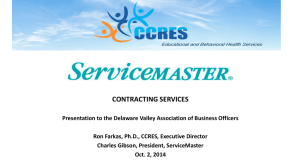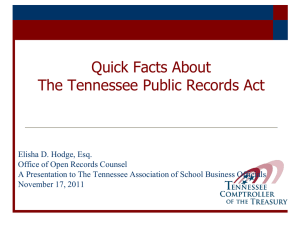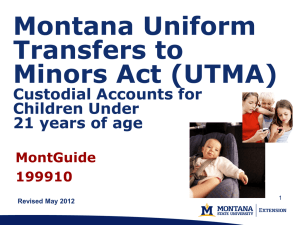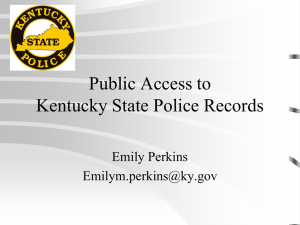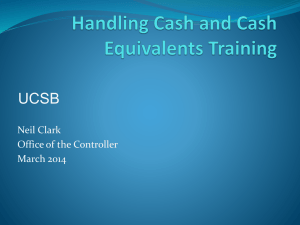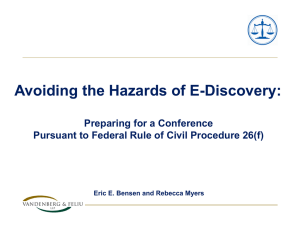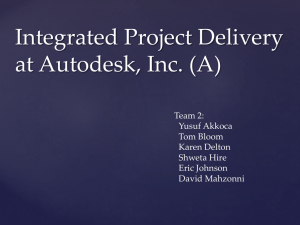Social Networking, Ethics & E-Discovery
advertisement
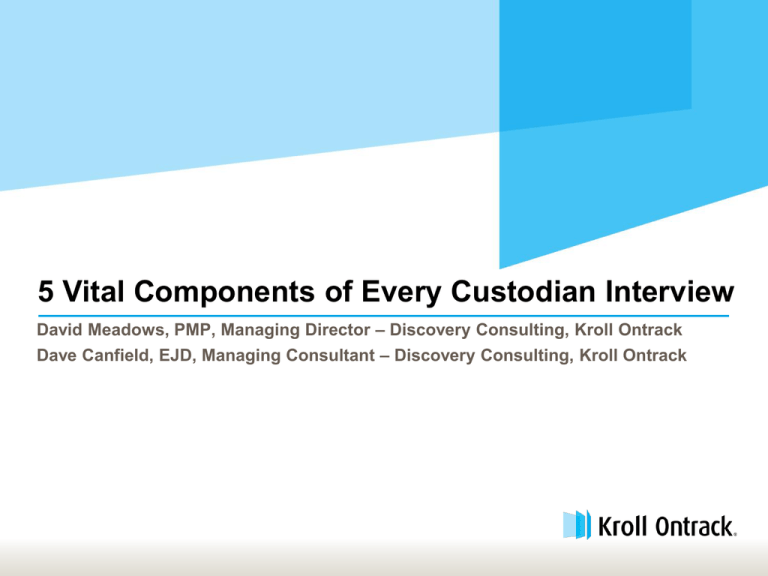
5 Vital Components of Every Custodian Interview David Meadows, PMP, Managing Director – Discovery Consulting, Kroll Ontrack Dave Canfield, EJD, Managing Consultant – Discovery Consulting, Kroll Ontrack David W. Meadows, PMP • • • • 2 Managing Director – Discovery Consulting, Kroll Ontrack Experience with information planning, data preservation, data collection, data processing, and complex data analysis Broad technology background covering enterprise networking, software design and development, and system implementations Previous work: electronic discovery consulting director for an international consulting firm, senior manager of information systems for a fund management company, project manager developing enterprise applications and head of IT for a Chicago law firm Dave Canfield, EJD • • • • • 3 Managing Consultant – Discovery Consulting, Kroll Ontrack Assists clients in the creation of discovery, data collection, case management, systematic processes, and documentation to support repeatable, efficient, and reliable e-discovery procedures Frequent expert witness for complicated IT systems Senior advisor in e-discovery for a global pharmaceutical company 20+ years experience in IT management and senior management Discussion Overview Introduction to Custodian Interviews » 1. Location of Relevant Documents » 2. Privilege Communication » 3. Compliance with Policies » 4. Other Important Custodians » 5. Background Data Other Considerations Conclusion 4 Introduction 5 As every good lawyer knows… Electronic information must be preserved whenever litigation is reasonably anticipated 6 Litigation is anticipated—now what? Initiate a litigation hold Critical aspect of a successful litigation hold: custodian interviews Information gathered during custodian interviews: » Sets the stage for the entire e-discovery process across the EDRM » Helps develop a detailed data map » Aids in preparation for 30(b)(6) depositions Remember: document all custodian interviews 7 5 Components of a Custodian Interview » 1. Location of Relevant Documents » 2. Privilege Communication » 3. Compliance with Policies » 4. Other Important Custodians » 5. Background Data 8 #1: Location of Relevant Documents 9 Location of Relevant Documents Ask specific questions and walk through a comprehensive list of potential data sources, including: » Business and personal: E-mail accounts Computers, iPods, flash drives Phone calls, voicemail, Skype Databases, cloud services Network servers, structured data systems Social media sites Text messages, instant messages Document management tools » Rule of thumb: anything with memory 10 Location of Relevant Documents Beware! Custodians will often identify only some of the locations where relevant documents could be stored 11 Location of Relevant Documents Do not forget the paper! » Ask where paper documents are stored and note the locations » File cabinet, briefcase at home, box in trunk of car, etc. 12 Location of Relevant Documents Case Study: » In Coleman (Parent) Holdings v. Morgan Stanley, a 2005 Florida case, Morgan Stanley was unaware of where it stored its electronic data, and was thus sanctioned for discovery abuses. A jury awarded the plaintiff $1.4 billion in compensatory and punitive damages. 13 #2 Privilege Communication 14 Privilege Communication 1. Inquire about whether the custodian communicated with attorneys in the matter 15 2. Create list of each attorney’s name and contact information 3. Identify and isolate potentially privileged documents Privilege Communication Benefits of separating privileged documents at the custodian interview stage: » Helps create an appropriate list of search terms to ensure privileged documents are not overlooked » Increases efficiency by saving time and money – teams can skip review of these documents » Improves overall defensibility of litigation hold when privilege is meticulously addressed at the custodian interview stage 16 #3 Compliance with Policies 17 Compliance with Policies Why is compliance more important now than ever in the e-discovery context? » According to IDC: Over 99% of all documents are now created and stored electronically 18 About 60 billion e-mails are created and sent each day Compliance with Policies: Document Retention Ask whether the custodian is aware of the company’s document retention policy—especially when it comes to electronic documents Note: companies are responsible for creating and instituting their own document retention policies specific to regulations for their specific company’s industry 19 Compliance with Policies: Legal Hold Parties that fail to initiate a defensible legal hold face spoliation sanctions A defensible legal hold starts with the custodian! Case study: » In U.S. v. Philip Morris, the court determined that Philip Morris destroyed e-mails on a monthly, system-wide basis for two months after a preservation order was issued. Sanctions imposed: $2,750,000, plus a $250,000 fine to each of the eleven corporate managers who failed to comply with the legal hold. 20 Compliance with Policies: Legal Hold Recommendations » Give the custodian another copy of the latest litigation hold notice » Remind the custodian of his/her preservation obligation » Provide the custodian with basic information about the case » Ask with whom (family, attorneys, co-workers, media, etc.) the custodian has discussed the matter » Remind the custodian that the matter is sensitive and that it should not be discussed outside the company » Answer any questions or direct the custodian to the appropriate resource 21 #4 Other Important Custodians 22 Other Important Custodians “Who else knows about this matter?” This question is a good start, but there is more to finding other custodians… 23 Other Important Custodians Depending on the nature of the matter, cover: » Outside vendors » Consultants » Contractors » PR professionals » Etc. Helps identify who should receive notice or third party subpoenas in some cases Do not forget departed custodians who were present during the relevant period 24 #5 Background Data 25 Background Data Provide to the custodian: » Basic case information » Client’s information Obtain from the custodian: » Name (and any previous names) » Employment history for the relevant time period 26 • Role • Tenure • Location • Contact information Other Considerations When Conducting Custodian Interviews 27 Other Considerations It is not just the where—it is also the how » Ask the custodian how they organize their documents » Determine whether there is a reliable organization structure and method; if not, you may have to arrange for organization 28 Other Considerations Keep connected » Tell the custodian who to call with questions or concerns, especially with regard to compliance issues » Remind the custodian to call counsel if she/he remembers anything later 29 Other Considerations Collection » Once potential sources are identified, it is recommended to immediately do the collection, both paper and electronic, if possible 30 Q&A 31
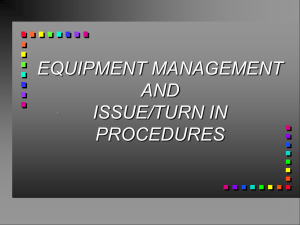
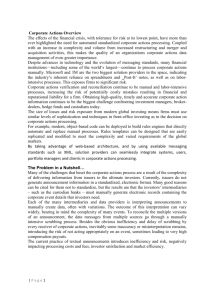
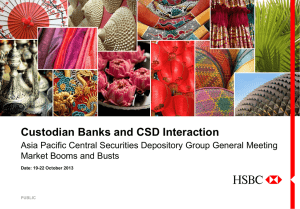
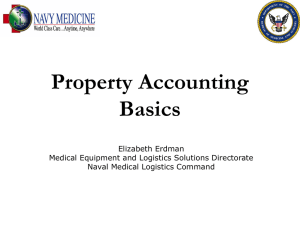
![Mark Whitenack Digital Assets PowerPoint Presentation []](http://s2.studylib.net/store/data/005383425_1-9cf830a5f2e9fc777daa963eb9460c8e-300x300.png)
